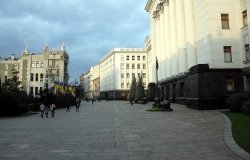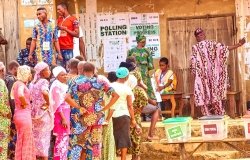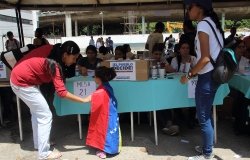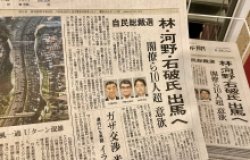Assessing the Ukrainian Parliamentary Elections: Half-steps and Dissonance
In the wake of the recent Ukrainian parliamentary elections on October 28, 2012, Kennan Institute Fulbright Scholar Mykhailo Minakov, who is an Associate Professor at the National University of Kyiv-Mohyla Academy, spoke with the Kennan Institute about issues surrounding the elections. Mary Elizabeth Malinkin, Kennan Institute, had the following discussion with him.

In the wake of the recent Ukrainian parliamentary elections on October 28, 2012, Kennan Institute Fulbright Scholar Mykhailo Minakov, who is an Associate Professor at the National University of Kyiv-Mohyla Academy, spoke with the Kennan Institute about issues surrounding the elections. Dr. Minakov is in residence at the Kennan Institute through February 2013 working on the project “Philosophy, Politics and Social Modernization in the Russian Empire, Soviet Union, Ukraine, Russia, and Belarus.” Mary Elizabeth Malinkin, Kennan Institute, had the following discussion with him:
Malinkin: These were the first parliamentary elections under President Viktor Yanukovych—were the outcomes what you expected?
Minakov: Yes, the outcomes were clear about a month ago. By the end of September, we could guess which parties were going to be voted in, and the only question was whether or not President Yanukovich would have a pro-presidential coalition that exceeded—or at least reached—300 votes in Parliament—meaning, would he have a constitutional majority in Parliament. There was no question that he would have a simple majority. As the results showed, he won 30% of the Party vote, and in the majoritarian system, he won more than 50%, securing about 190 seats for the Party of Regions in total. In addition, the Communist Party, which is eager to cooperate with the Party of Regions, won 32 seats. When you add in the pro-Yanukovych non-partisan majoritarian MPs, there will be a stable pro-presidential majority in this Parliament.
Malinkin: Do the results show that President Yanukovych has kept his commitment to having a democratic election? How fair was the election in your estimation?
Minakov: I would agree with the evaluation by the joint mission of Western observers that included the OSCE/ODIHR, European Parliament, and NATO Parliamentary Association Mission. The Mission stated that these elections were far from being free and fair. This was in part due to many systemic flaws in the electoral law implementation and in part due to the way the vote was counted. The worst offenses were on Election Night, after all the ballots were cast and the vote had ended. The way the votes were counted cannot be recognized as transparent and there are many votes, especially in the majoritarian part, that are doubted to represent the actual vote cast. The majoritarian vote was as wild as it was in the 1990s—bribery, restricted access to the media, and the crudest, most unacceptable behavior was witnessed in the localities.
Malinkin: There has been growing international criticism of undemocratic policies under Yanukovych—Secretary of State Hilary Clinton has called the election ‘a step backward’—do you agree with this assessment?
Minakov: I agree that it’s a step backward, but it’s not as bad as many opposition leaders could have expected, so this aspect of the party-based competition was more or less acceptable. What happened with the majoritarian half was actually the real step backward. Regarding the majoritarian portion of the elections I fully agree with this statement. The mixed system is a tricky thing. It has been intentionally designed to make outside observers less critical—the ruling party is able to secure dominance of the Parliament, and at the same time they are able to present the data and arguments to show that there are democratic elements—at least a minimum level of democracy—in Ukraine.
Malinkin: Will Ukrainian constituencies be adequately represented in the newly elected Verkhovna Rada?
Minakov: There are two types of constituencies according to the current electoral system: 1) national constituencies based on ideological preferences and 2) local constituencies based on the interests of local communities. When we talk about ideological representation, we have lost the presence of democratic parties in Parliament. Overall Ukrainians support either conservative or radical parties, and democratic parties do not have support to be in Parliament any more. A quarter of seats now belong to pro-totalitarian parties (namely the extreme right "Svoboda” Party that openly regards Nazis as their ideological predecessors and the far left Communist Party), one third belong to the Party of Regions, which is not a champion of democracy, and the United Opposition has dropped its former democratic values in its messages. The United Opposition is increasingly nationalist, though moderate, now. At the local level, communities could not actually vote in a way that they would have good and stable relationships with their representatives in Parliament. The winners of the majoritarian part of the elections are those who paid more than their competitors. The majoritarian elections were full of bribery and buying of votes. At the same time, and paradoxically, the small group of democrats and liberals who did win only won thanks to the majoritarian elections.
Malinkin: Were there clear allegiances to parties based on voters’ ethnicity or region? Based on age?
Minakov: Yes and no. The core voters of the Communist Party and Svoboda were from the East and West, respectively. At the same time, Svoboda, has gained very strong support in Kyiv and their support in Eastern Ukraine has grown as well. There is also a new party, Vitaliy Klychko’s Ukrainian Democratic Alliance for Reform (UDAR), which received approximately 10% of the vote in almost all oblasts of Ukraine. So there is a mixture of regional and national parties in this new Parliament. According to exit polls, a large portion of the youth population, 18-24 year-olds, supported UDAR and the Communists—so the generation that does not remember the Soviet Union seems to be supporting leftist ideas in the form of the Communist Party or populist movements. The part of the population that remembers the USSR during Perestroika, those who are 44-62 years-old, largely voted for the Party of Regions or for Svoboda. The majority of those who work and pay taxes however, 25-43 year-olds, voted for either the Party of Regions or the United Opposition.
Malinkin: What kind of role did personalities of the candidates play in the elections?
Minakov: The official platforms of the parties were not really analyzed or discussed in Ukrainian society. The main issue for the debates remained the leaders. These parties are like fan clubs that support Vitaliy Klychko, Yulia Timoshenko or Viktor Yanukovich. The Communist Party and Svoboda were the least connected with their leaders and instead it was their ideologies that were important. Populism was booming in the Party of Regions, the United Opposition, and UDAR campaigns.
The Kennan Institute scholars and staff will continue to consider the effects of the election and what it means for Ukraine. Please see our website for more details on upcoming events on this topic and related issues.
About the Authors

Kennan Institute
The Kennan Institute is the premier US center for advanced research on Eurasia and the oldest and largest regional program at the Woodrow Wilson International Center for Scholars. The Kennan Institute is committed to improving American understanding of Russia, Ukraine, Central Asia, the South Caucasus, and the surrounding region though research and exchange. Read more













